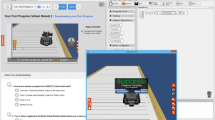Abstract
This study investigated the effects of learner control and program control on the achievement and continuing motivation of high school students. The influence of the availability of computer-delivered instruction on student motivation was also examined. Continuing motivation was measured by student choice of learner control or program control as the mode for a second instructional program after subjects completed an initial program under their randomly assigned mode. Results revealed a highly significant difference in continuing motivation favoring learner over program control. The differences in posttest performance and performance during instruction between learner and program control were not significant. The data also revealed significant preferences to study both science and an alternative subject when they are presented by computer over when they are not.
Similar content being viewed by others
References
Bruner, J. S. (1966).Toward a theory of instruction. Cambridge, MA: Belknap Press of Harvard University Press.
Campanizzi, J. (1978). The effects of locus-of-control and provision of overviews upon response latency and achievement in a computer-assisted instructional sequence.Dissertation Abstrcts International, 39(2-A) 830A. (University Microfilms No. 78-12, 325).
Campbell, V. N., & Chapman, M. A. (1967). Learner control vs. program control of instruction.Psychology in the Schools, 4, 121–130.
Carrier, C., Davidson, G., Higson, V., & Williams, M. (1984). Selection of options by field independent and dependent children in a computer-based concept lesson.Journal of Computer-Based Instruction, 11, 49–54.
Carrier, C., Davidson, G., & Williams, M. (1985). The selection of instructional options in a computer-based coordinate concept lesson.Educational Communication and Technology Journal, 33, 199–212.
Clark, R. E. (1983). Reconsidering research on learning from media.Review of Educational Research, 53, 445–459.
deCharms, R. (1968).Personal causation. New York: Academic Press.
Deci, E. L. (1975).Intrinsic motivation. New York: Plenum.
Energy choices and challenges. (1984). Washington, DC: Energy Source Educational Council.
Fisher, M. D., Blackwell, L. R., Garcia, A. B., & Greene, J. C. (1975). Effects of student control and choice on engagement in a CAI arithmetic task in a low-income school.Journal of Educational Psychology, 67, 776–783.
Frison, C. G. (1984).Imagery, postquestions, and children's learning from prose. Unpublished doctoral dissertation, Arizona State University.
Fry, J. P. (1972). Interactive relationship between inquisitiveness and student control of instruction.Journal of Educational Psychology, 63, 459–465.
Gray, S. H. (1987). The effect of sequence control on computer assisted learning.Journal of Computer-Based Instruction, 14, 54–56.
Holloway, R. L. (1978). Task selection and locus of control in two ability groups' recall.Contemporary Educational Psychology, 3, 118–126.
Kinzie, M. B., Sullivan, H. J., & Berdel, R. L. (1988). Learner control and achievement in science computer-assisted instruction.Journal of Educational Psychology, 80, 299–303.
Lepper, M. R. (1985). Microcomputers in education: Motivational and social issues.American Psychologist, 40(1), 1–18.
Levin, H. M., Glass, G. V., & Meister, G. R. (in press). Cost-effectiveness of computer-assisted instruction.Evaluation Review.
Maehr, M. L. (1976). Continuing motivation: An analysis of a seldom considered educational outcome.Review of Educational Research, 46, 443–462.
Mager, R. F. (1964). Learner-controlled instruction—1958–1964.Programmed Instruction, 4(2), 1, 8, 10–12.
Malone, T. W. (1981). Toward a theory of intrinsically motivating instruction.Cognitive Science, 4, 333–369.
Merrill, M. D. (1975). Learner control: Beyond aptitude-treatment interactions.AV Communications Review, 23, 217–226.
Merrill, M. D. (1980). Learner control in computer based learning.Computers and Education, 4, 77–95.
Pascal, C. E. (1971). Instructional options, option preference, and course outcomes.The Alberta Journal of Educational Research, 17(1), 1–11.
Pascarella, E. T., Walberg, H. J., Junker, L. K., & Haertel, G. D. (1981). Continuing motivation in science for early and late adolescents.American Educational Research Journal, 18, 439–452.
Pollock, J., & Sullivan, H. J. (1988, April).Learner control, achievement, and continuing motivation in computer-based instruction. Paper presented at the annual meeting of the American Educational Research Association, New Orleans.
Rotter, J. B. (1966). Generalized expectancies for internal versus external control of reinforcement.Psychological Monographs, 80(1) (Whole No. 609).
Seymour, S. L., Sullivan, H. J., Story, N. O., & Mosley, M. L. (1987). Microcomputers and continuing motivation.Educational Communication and Technology Journal, 35, 18–23.
Snow, R. E. (1980). Aptitude, learner control, and adaptive instruction.Educational Psychologist, 15, 151–158.
Tennyson, R. D. (1980). Instructional control strategies and content structure as design variables in concept acquisition using computer-based instruction.Journal of Educational Psychology, 72, 525–532.
Tennyson, R. D. (1981). Use of adaptive information for advisement in learning concepts and rules using computer-assisted instruction.American Educational Research Journal, 18, 425–438.
Tennyson, R. D., & Buttrey, T. (1980). Advisement and management strategies as design variables in computer-assisted instruction.Educational Communication & Technology Journal, 28, 169–176.
Wang, M. C. (1983). Development and consequences of students' sense of personal control. In J. M. Levine and M. C. Wang (Eds.),Teacher and student perceptions: Implications for learning. Hillsdale, NJ: Erlbaum.
Wang, M. C., & Stiles, B. (1976). An investigation of children's concept of self-responsibility for their school learning.American Educational Research Journal, 13, 159–179.
White, M. A. (1983). Synthesis of research on electronic learning.Educational Leadership, 19(5), 13–15.
Witkin, H. A., & Goodenough, D. R. (1981).Cognitive styles: Essence and origins. Psychological Issues, Monograph 51. New York: International Universities Press.
Zimbardo, P. G. (1969).The cognitive control of motivation. Scott, Foresman and Company: Glenview, IL.
Author information
Authors and Affiliations
Additional information
The research reported herein was conducted while she was a doctoral student at Arizona State University.
Rights and permissions
About this article
Cite this article
Kinzie, M.B., Sullivan, H.J. Continuing motivation, learner control, and CAI. ETR&D 37, 5–14 (1989). https://doi.org/10.1007/BF02298286
Issue Date:
DOI: https://doi.org/10.1007/BF02298286




